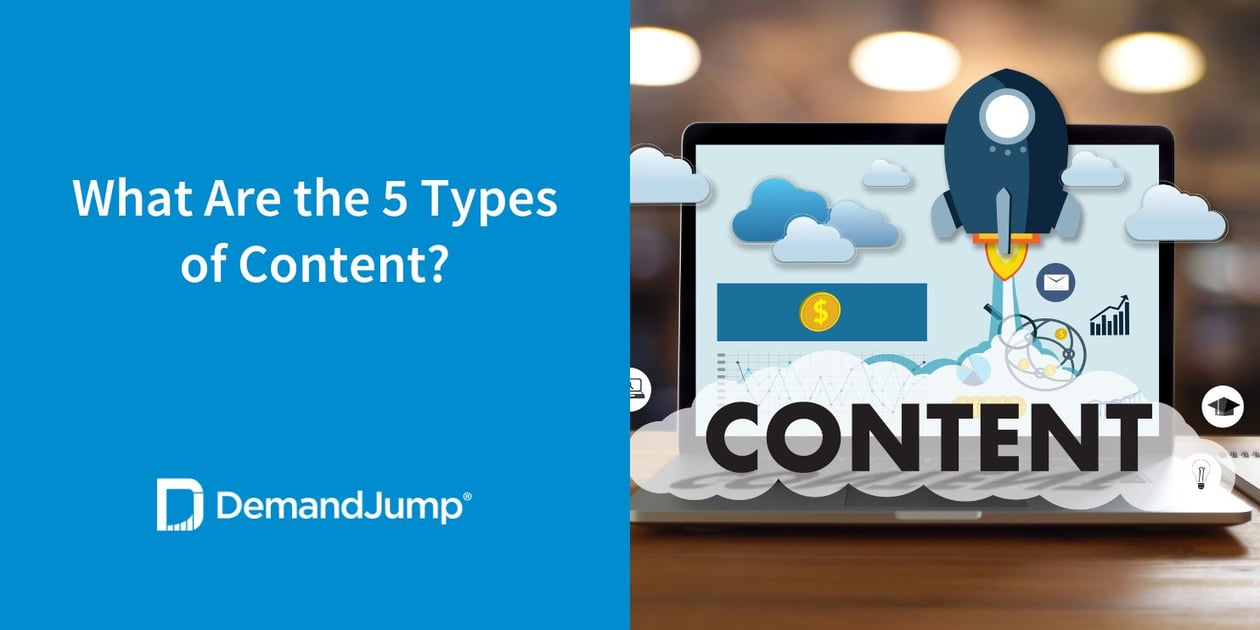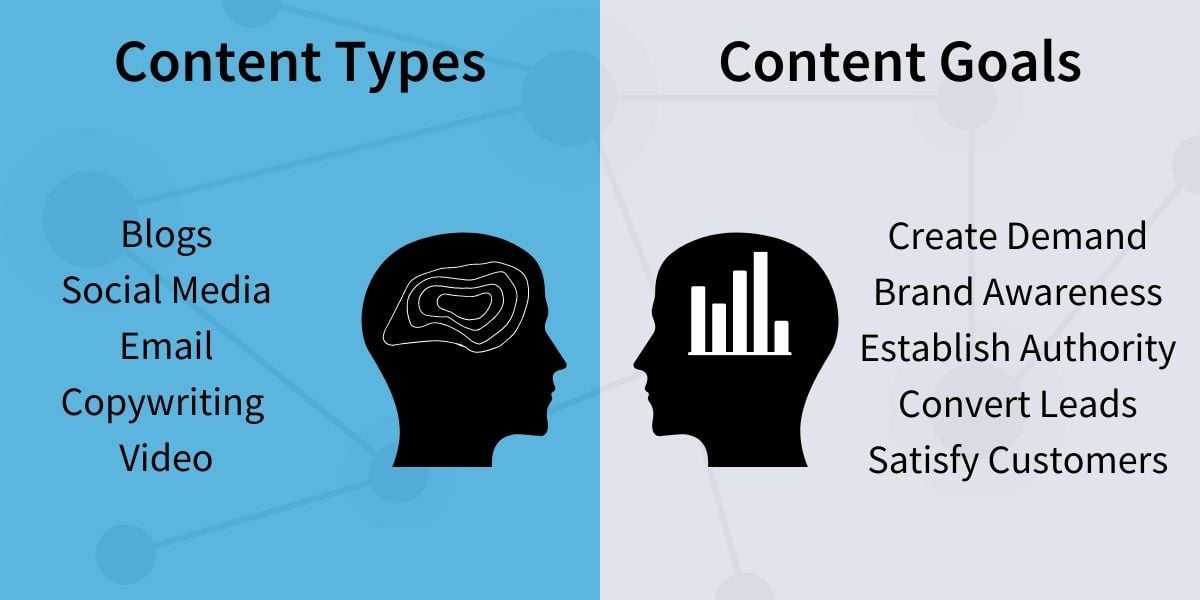What Are the 5 Types of Content?
October 4, 2022 •Chris Gabryszewski

Content, content, content… if you’re involved in marketing in any capacity, this word probably bounces around your head all day until it loses all meaning. To break out of buzzword territory, content is information that is presented as writing, images, video, audio, or a combination of these formats. It also happens to be a very effective way to market your business. Well-written blog posts can reach the number one spot on Google (which has the highest click through rate at 28.5%), viral social media posts can make your brand visible to millions of potential customers, and helpful DIY videos can show off the best features of your product or service.
Content marketing is effective, but with so many options, it can be overwhelming when starting out. To help you navigate your choices, we put together this guide on the 5 most common types of content with examples. Let’s dive in!
What Are the Types of Content in Marketing?
There are many types of content in digital marketing, and most fall into the following 5 categories:
- Blogs
- Social Media
- Copywriting
- Video
While it’s important to understand which types of content your audience enjoys interacting with, you should also know what the intent of each piece of content is. For example, is your blog meant to educate and build your authority as a resource in your industry? Is the goal of your video to announce a new product that will transform lives? Do you want someone who sees your social media post to visit your online store?

To give a little more context, let’s see how each type of content can be used along with some successful examples.
5 Types of Content Marketing
1. Blogs: Blogs are no longer just for recipes and travel (although they’re still great for that). Writing and posting articles to your website is an effective way of educating potential customers on the value you offer, so they feel more comfortable buying from you.
For example, Microsoft’s blog titled “Collaboration on unique resin spurs creation of the Ocean Plastic Mouse” educates readers on how Microsoft’s innovation goes beyond software; it also includes sustainability. This shows potential customers that Microsoft is always developing new, exciting technology. And for the environmentally conscious, finding ways to recycle ocean plastic into computer parts is a huge plus.
2. Social Media: Posting to social media accounts is a great way to get your business discovered and to make announcements and interact with your current followers. By tailoring your posts to different platforms like Facebook, YouTube, and LinkedIn, you can connect with different segments of your audience.
Viral campaigns can be effective even when they’re just a flash in the pan, but if you can create one that lasts, even better. An example of a lasting campaign is Apple’s #ShotOniPhone Instagram hashtag that has inspired over 21.9 million posts since launching in March of 2015. By leveraging user-generated content, Apple gets free marketing that shows off how easy it is for anyone to take beautiful photos with just an iPhone.
3. Email: Email marketing tends to get a bad rap, but when done well, it can be used for education and to build customer loyalty. Monthly newsletters can give advice on how to solve common problems in your industry, and news about products and deals can bring customers back to your store.
For example, Lowe’s could send out a newsletter that contains steps to building a treehouse in your backyard, which would get parents excited about purchasing lumber, powertools, and hardware.
4. Copywriting: Words matter. Whether you’re rebranding your website, adding product descriptions, or writing an ebook about best practices in your industry, each interaction with your customers should be engaging and informative.
For a timeless example of how great copy communicates value and gets remembered, check out this Rolls-Royce ad that ran from 1958-1962, which boasts: “At 60 miles an hour the loudest noise in the new Rolls-Royce comes from the electric clock.”
5. Video: They say a picture is worth a thousand words, so how much value does that place on video content? A lot. According to Pew Research, YouTube was the most popular social media platform in the U.S. in 2019. To take advantage of video content’s popularity, you could make and post videos for DIY, how-to, announcements, reviews, and so much more.
For example, Guitar Center’s “How To Use a Guitar Pick (and Basic Strumming Patterns)” video makes a somewhat intimidating hobby feel accessible to anyone who wants to learn. And, when someone decides to pick out their first guitar, they’ll go to Guitar Center after watching their helpful video.
What Types of Content Are Popular?
The most popular types of content are blogs and videos that rank on the first page of Google and YouTube search results. There are an estimated 5.6 billion searches made on Google everyday, while videos on the most popular social media platform, YouTube, receive about 5 billion daily views. If you’re not creating quality content for these platforms, you’re missing out.

The challenge, however, is knowing exactly what to create to reach your intended audience. These platforms are so successful because users search for the content they want to see. That enables you to create the exact types of content that users are searching for. There’s usually a lot of guesswork involved, but there doesn’t have to be. With DemandJump’s keyword research and content planning tools, you can see the exact questions people are searching, so you can create content that solves their problems and fosters a relationship.
What Is the Most Engaging Type of Content? What You Write with DemandJump!
With Google’s helpful content update, it’s more important than ever to engage your audience with your content. Blogs written primarily for search engine algorithms will no longer cut it. In fact, those articles that rely on gaming the system with tactics like keyword stuffing will actually lose rankings. So what’s the solution? Writing content that puts readers first while still following SEO best practices. We know that’s easier said than done, and that’s why we’re here to help.
At DemandJump, the content we’ve written—and the pieces our customers have written using our tools and best practices—have seen a significant boost in rankings as the helpful content update rolled out. Our Insight Reports make it easy to know what topics to write about to reach a specific audience, and our Content Briefs provide you with high value keywords that help you get your point across. Ready to get started writing content that boosts your rankings instead of hurting them? We thought so.
Featured Articles
Categories
- Attribution Tracking (13)
- Channel Optimization (11)
- Consumer Insights (68)
- Content Marketing (251)
- Data Science (8)
- Digital Marketing (6)
- Digital Transformation (26)
- Enterprise (10)
- Lead Generation (14)
- Market Intelligence (8)
- Marketing Analytics (39)
- Marketing Attribution (57)
- Marketing Management (153)
- Marketing Operations (86)
- Organic Search (222)
- Paid Search (52)
- Pillar-Based Marketing (63)
- Programmatic Advertising (9)
- SaaS Content (14)
- SaaS Marketing (29)
- Search Marketing (111)
- SEO Keyword Research (28)
- SEO Pillar (18)
- SEO Strategy (46)
- SMB (5)
- Website Content (12)


